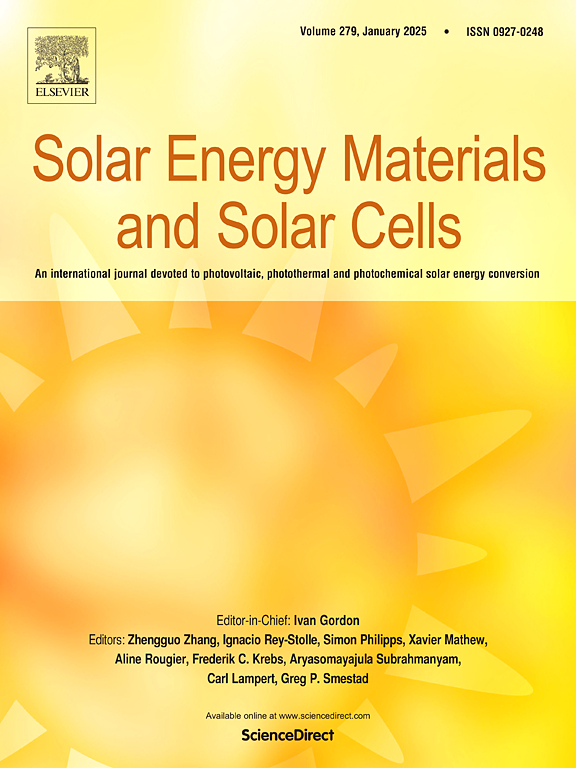由丙烯酸酯viologens和全氟碳纳米管修饰的透明电极实现的无泄漏柔性和可拉伸电致变色器件
IF 6.3
2区 材料科学
Q2 ENERGY & FUELS
引用次数: 0
摘要
电解液泄漏和电极易损性一直是阻碍柔性电致变色器件发展的重要因素。液体电解质虽然具有离子传递效率,但在机械应力作用下容易发生泄漏,而凝胶电解质则面临力学约束。传统的氧化铟锡(ITO)电极是刚性的,当受到变形时容易开裂,限制了它们的灵活性。为了解决这些挑战,本研究将无泄漏电解质薄膜与通过直接芳基化反应合成的全氟碳纳米管(FCNTs)无缝集成到可光固化的聚合物基质中。氟化纳米管表面保留了碳纳米管的固有性质,同时增强了碳纳米管束的分散和防止其聚集。通过将基于丙烯酸酯violo原的电解质薄膜与fcnt修饰的电极集成在一起,柔性ECDs实现了高透射率对比度、机械灵活性和操作稳定性。所制备的设备的耐久性超过12000秒,严格的弯曲测试证实了它们的坚固性。此外,当与PDMS衬底结合时,可以成功地制造出可拉伸的ECDs。值得注意的是,离子凝胶电解质在拉伸下有效地发挥作用,没有任何泄漏问题,证明了电极和活性电致变色层的耐久性。目前的工作解决了电解质泄漏和电极易损方面的关键挑战,为下一代ECDs和高度柔性和可拉伸的可穿戴技术铺平了道路。本文章由计算机程序翻译,如有差异,请以英文原文为准。

Leakage-free flexible and stretchable electrochromic devices enabled by acrylate viologens and perfluorinated CNT-modified transparent electrodes
Electrolyte leakage and electrode fragility have been persistent obstacles in advancing flexible electrochromic devices (ECDs). Though efficient for ion transfer, liquid electrolytes are prone to leakage under mechanical stress, while gel electrolytes face mechanical constraints. Conventional indium tin oxide (ITO) electrodes are rigid and susceptible to cracking when subjected to deformation, restricting their flexibility. To resolve these challenges, this study seamlessly integrates leakage-free electrolyte films formed by incorporating acrylate viologen into a photocurable polymer matrix, with perfluorinated carbon nanotubes (FCNTs) synthesized through a direct arylation reaction. The fluorinated nanotube surface preserves CNTs' intrinsic properties while enhancing dispersion and preventing aggregation of CNT bundles. By integrating acrylate viologen-based electrolyte films with FCNT-modified electrodes, the flexible ECDs achieve high transmittance contrast, mechanical flexibility, and operational stability. The prepared devices maintain durability beyond 12,000 s, and rigorous bending tests confirm their robustness. Furthermore, when combined with PDMS substrates, stretchable ECDs are successfully fabricated. Notably, the ion gel electrolyte functions efficiently under stretched without any leakage concerns, demonstrating the durability of the electrode and the active electrochromic layers. The current work addresses key challenges in electrolyte leakage and electrode fragility, paving the way for next-generation ECDs and highly flexible and stretchable wearable technologies.
求助全文
通过发布文献求助,成功后即可免费获取论文全文。
去求助
来源期刊

Solar Energy Materials and Solar Cells
工程技术-材料科学:综合
CiteScore
12.60
自引率
11.60%
发文量
513
审稿时长
47 days
期刊介绍:
Solar Energy Materials & Solar Cells is intended as a vehicle for the dissemination of research results on materials science and technology related to photovoltaic, photothermal and photoelectrochemical solar energy conversion. Materials science is taken in the broadest possible sense and encompasses physics, chemistry, optics, materials fabrication and analysis for all types of materials.
 求助内容:
求助内容: 应助结果提醒方式:
应助结果提醒方式:


